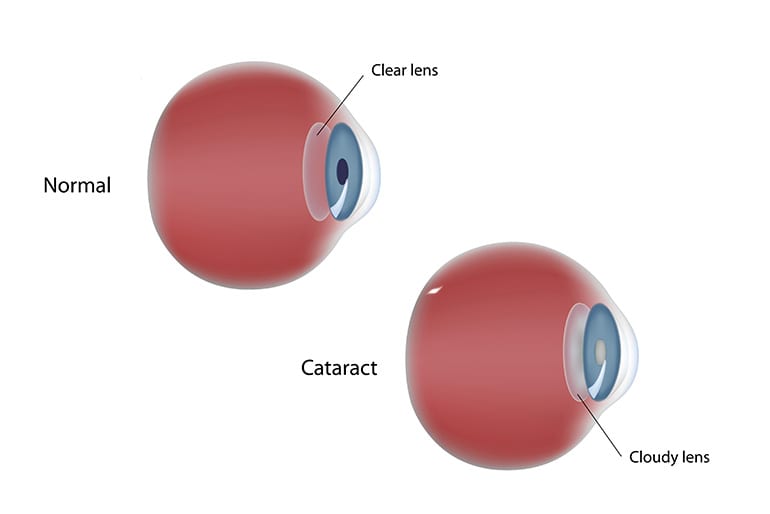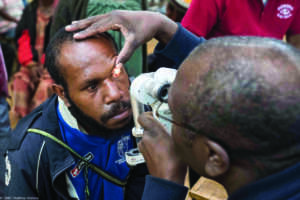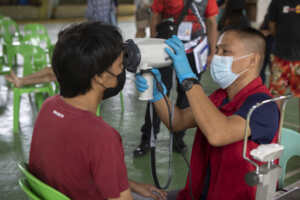What is a cataract?
Stories | April 2, 2024
What is a cataract?
Cataracts are the leading cause of blindness worldwide and responsible for vision loss in 100 million people – most of them living in developing countries. Many are people with disabilities.
A cataract is the milky clouding of the eye’s natural lens. Cataracts can occur in one or both eyes.
Trying to see with a cataract has been likened to fogging on a camera lens. Cataracts reduce clear vision and, if left untreated, can cause permanent, lifelong damage and blindness.
Cataracts in developing countries
Blindness from cataracts is also avoidable in most cases. The World Health Organization reports that about 80% of vision impairment is avoidable.
Sadly, many people with cataracts in developing countries lack access to affordable care and eye surgery. This means they are less able to prevent cataracts from leading to blindness than those in more developed countries.
While cataracts are most commonly diagnosed among people aged 60 and up, they can also occur in younger people and children. Children require early detection of cataract formation and swift treatment for their eyesight to develop normally.

What are the symptoms of cataracts?
The first and foremost symptom of cataracts is blurry vision.
Other Cataract symptoms
- Dim vision
- Vision loss
- Increased difficulty seeing at night
- Sensitivity to light and glare
- A need for brighter light when reading
- Distortion or ‘double vision’ in the affected eye

Cataract types
Different cataract forms are categorised according to how they begin. The three most common types of cataract formation are:
Posterior subcapsular cataract
A posterior subcapsular cataract forms at the back of the lens, right beneath the lens capsule, which is its outer lining. This cataract reduces vision in bright light, making reading or seeing in well-lit conditions challenging.
Individuals might also experience halos around lights, which can be particularly disturbing at night. Posterior subcapsular cataracts tend to develop more rapidly than other types. They are often seen in people with health conditions such as diabetes, or those taking high doses of steroid medications.
Posterior subcapsular cataracts are the most common complication of cataract surgery. In this case, they are called secondary cataracts and can occur even if the previous eye surgery was successful.
Cortical cataract
Cortical cataracts occur in the lens cortex – the part of the lens that surrounds the central nucleus. This type manifests as white, wedge-like opacities that start at the outer edge of the lens and work their way to the centre in a spoke-like fashion.
People with cortical cataracts often find difficulty with glare and have issues with depth perception, making tasks like driving at night particularly challenging. Cortical cataracts are more common in individuals with a history of diabetes and are progressive, emphasising the importance of regular eye examinations for early detection and intervention.
Nuclear cataract
Nuclear cataracts develop in the central nucleus of the lens and are the most common age-related cataracts. As the most common type of cataract, they gradually cause the nucleus of the lens to become hard and yellow, significantly affecting the clarity of vision.
Early on, individuals might notice a temporary improvement in their near vision, often referred to as “second sight.” But as the cataract grows, it leads to significant blurring and dimming of vision.

Who is at risk of developing cataracts?
Cataracts develop in a range of people. Some eye diseases are hereditary, such as congenital cataracts. There are also contraindications (other diseases which increase your risk of developing cataracts).
Cataract risk factors
- Diabetes
- Long-term and unprotected exposure to UV light rays
- Smoking
- Family history of cataracts
- Eye trauma caused by injury – this is known as traumatic cataracts
How are cataracts treated?
The great news is that there are very safe surgical treatments available.
Cataract surgery involves an eye doctor (ophthalmologist) removing the clouded lens from the eye and replacing it with a clear, artificial lens. This lens is very durable and should last a lifetime.
If surgery on both eyes is required, procedures will be conducted separately and several weeks apart.
In about 90% of cases, people who have cataract surgery have better vision. After cataract surgery, your doctor may recommend that you wear sunglasses for about a week

About Miracles Day
Thursday, 18 August 2022 is Miracles Day. On this day, Australians can give someone the Miracle gift of sight, with a 12-minute operation costing just $33.
This year is the 10th anniversary of Miracles Day, and you can help give over 50,000 people worldwide the sight-saving surgery they need to see again.
To find out more, visit cbm.org.au/miraclesday
https://www.cbm.org.au/stories/what-is-a-cataract
Related Stories

Advent 2025: Jesus’ way leads to fullness
The way of Jesus gives people freedom and empowers them to live out their God-given purpose. The last few weeks...

Advent 2025: Preparing the way produces fruit
John the Baptist called people to prepare for God’s presence through repentance and by producing fruit (acts of justice,...

From sports to advocacy – the journey of the Isiolo Umbrella Disability Group
The Promoting Inclusive Delivery of Eye Care (PRIDE) Project is a...
